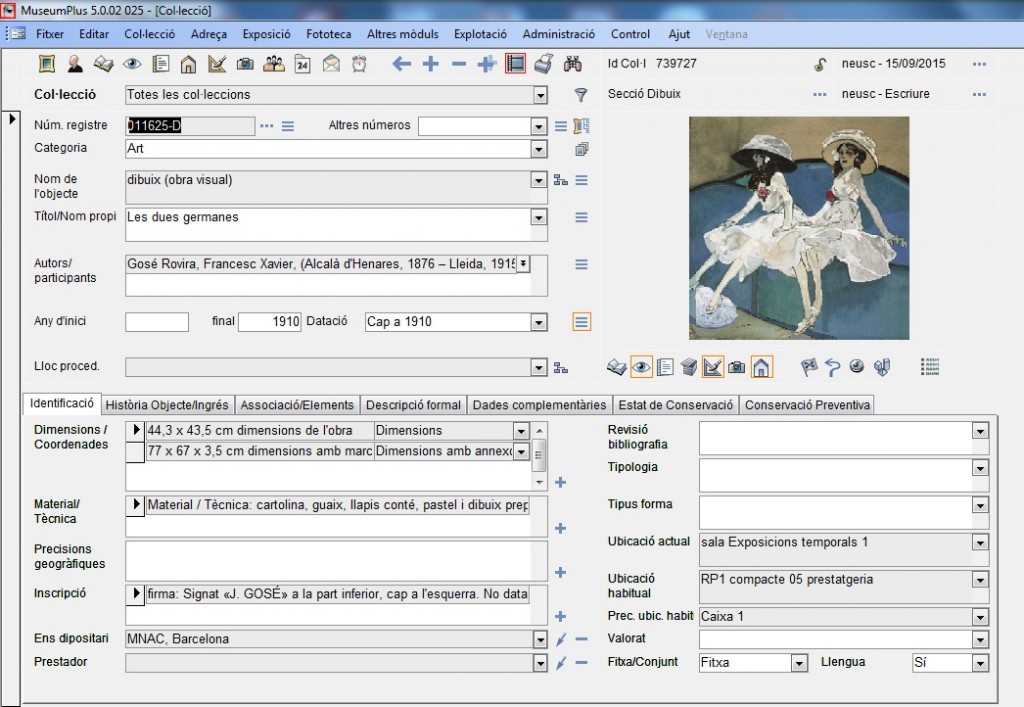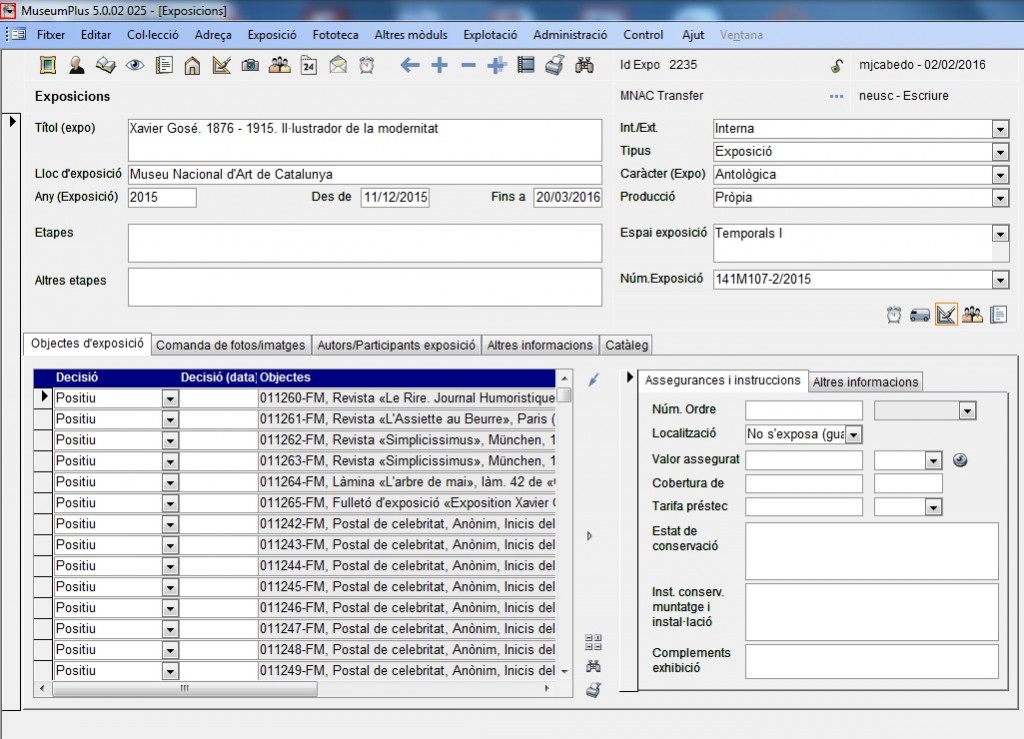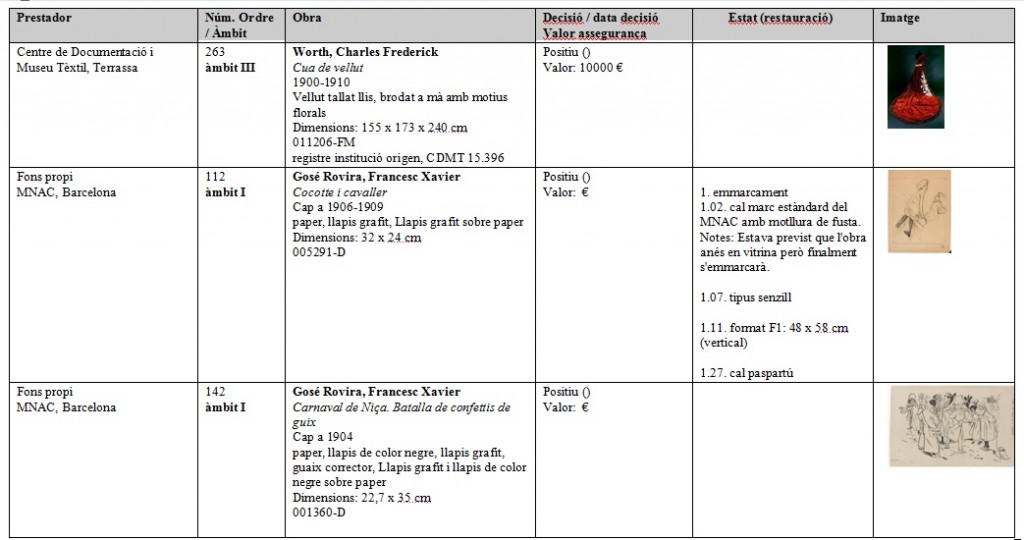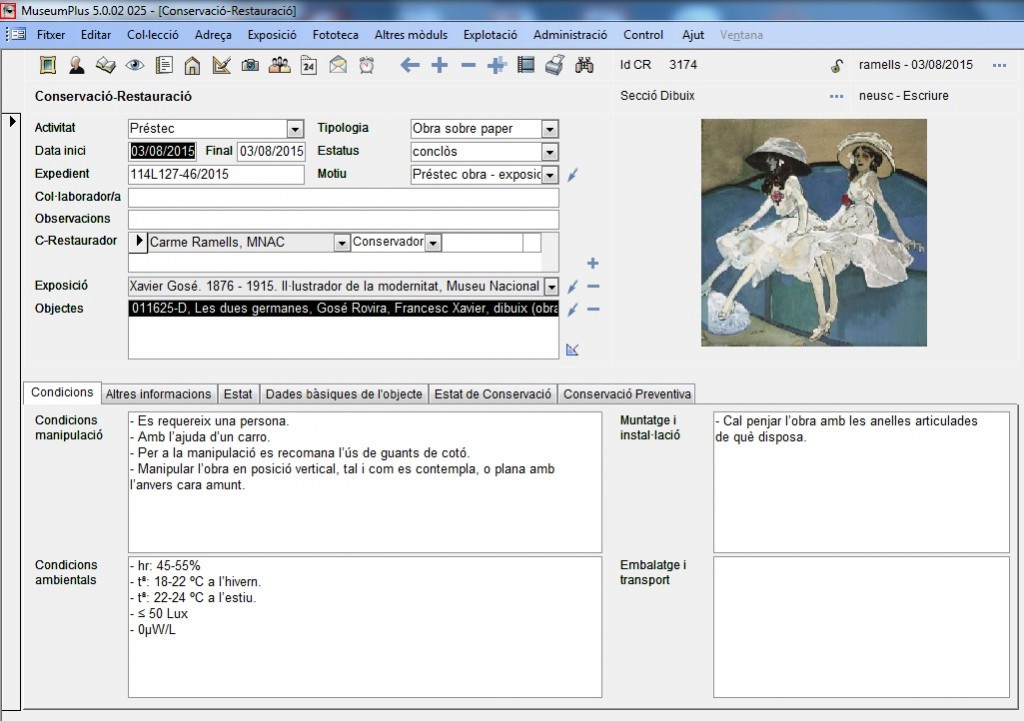Neus Conte/Marta Masafret
The Museu Nacional manages a large and varied volume of objects of art, some 290,000 works distributed in diverse collections: Romanesque Art, Gothic Art, Renaissance and Baroque, Modern Art (including Photographic Heritage), the Cabinet of Drawings and Prints, and the Numismatic Cabinet. Of this total of works, 164,500 are documented in the management system of collections MuseumPlus, administered by the Unit of Documentation of Collections of the museum. The information about the works in MuseumPlus is provided by the conservators and restorers and also by the technical staff of Registry and Exhibitions.
Museumplus is not the first system of management that we have used in the museum. Previously, we had used DAC – Assisted Documentation of Collections which started to function in 1993 until, due to its lacks at a level of networking and of the obsolescence of the technological platform, an intensive work was started on the evaluation of management systems of collections. Finally, in October 2006, we started to work with MuseumPlus, which was the programme chosen and acquired by the Generalitat de Catalunya for the documentation and management of movable heritage in Catalonia.
Working on the documentation of a museum may seem to be a very grey work and not very exciting, but it is essential, as it is to take care of the inventory, of computerising, ordering and systemising the information that results from the acquisition, control, conservation, restoration, exhibitions and research of the collections of the museum.
In our museum, this task is really difficult, given the enormous and heterogeneous amount of works guarded. If we add to this the complex structure of the different technical departments who work on this, and the different work processes, which all together make the fact that the volume of work and the mechanisation of the tasks is considered to be a “minor” task, and that nobody is “motivated” to do, while everyone claims for it being done, regarding the rest of the activities and projects of the museum.
Pros and cons
After more than 9 years since we started using MuseumPlus, we can say that it has led to major changes at a level of management:
- we now have a fast tool at a level of exploitation and recuperation of the information introduced
- it is flexible
- with good functioning in network
- it allows the tasks of the technical staff to be automated, and
- it guarantees the quality and systemisation of the data
It should be said, that among its disadvantages we find that it runs currently under a technologically obsolete platform, it should be improved and it has limits both at a level of development and in terms of technical service. We are convinced that some improvements are required at a “base” level so as to achieve optimum results in terms of the massive entry of registration, the exploitation of the data, and the uploading of information onto the website, capable of generating metadata in the different standard formats. Discussions and analyses are being carried out regarding possible ways of improvements, with experts in documentation of various museums from the Network of Art Museums of Catalonia and also by the Heritage Directorate of the Generalitat (Catalan Government).
Objectives of the documentation of the collections
From Documentation of Collections, we try to carry a series of tasks and operations aimed at getting a standardised information that allows an unambiguous representation of the object and that enables its recuperation:
- to standardise, automate, and structure all the processes of integral management of the documentation, by means of mechanisms and procedures of control, standardisation and systemisation
- to analyse and plan the needs for information, by guaranteeing quality data if the established regulations are made use of – user manuals, procedural manuals – and the management guidelines and the strategic plan are followed
- to design policies of information and to develop technical and management strategies
The intention is to establish priorities, teamwork with the rest of the specialised technical staff and to plan in a suitable way so as to achieve a transparency and clarity of the service, with greater efficiency and speed in the work processes:
- to periodically evaluate the quality of the system and the data – maintenance and uniformity; the follow-up of the project – periodical comparison of what was foreseen and planned; and the level of tasks and the resources invested
- to achieve a good exchange of data with other management systems of the museum – documentary management, website, etc. We offer more than 8,600 works available to the public in the online collection, that throughout this year and the next few years will increase notably.
MuseumPlus is a useful tool but by no means perfect, which we have adapted to our needs. It allows the daily tasks of the technical staff to be lightened and offers access, exploitation and retrieval of the information in a correct, quick and safe way, provided that the circuits and the responsibilities of each users’ type are well-defined, and that the decision-making ensures the good functioning of the system and the loyalty of the users. But managing to do so is not an easy task and requires a good coordination with the rest of the areas of the museum and with other institutions – the Generalitat de Catalunya, and the developing company.
Projects
Successfully carrying out this project helps the Museu Nacional in its challenge to be one of the major museums of Europe, given that it provides us with a tool and the necessary resources to boost the diffusion of the collections of the museum, such as Europeana; it benefits all the users, who have seen the work routines changed and improved, as well as the allocation of resources, and above all, it has contributed to the fact of making a technological and methodological jump in the daily tasks, in terms of the quality of the data, and its control and revision. The enlargement of the online collection will be a major step with regard to making the collections more accessible and the knowledge generated, based on the expert task of research and the analysis of the works.
The last two projects in which we have been collaborating from the Department of Documentation has been the coordination of the “Technical commission of standardisation and documentary development” of the Network of Art Museums and as a pilot museum in the revision of the field “name of the object” for implementing the thesaurus Art & Architecture Thesaurus (AAT) of the Getty Research Institute. These experiences are the ones we will explain in a new post of this blog.
Related links
Documentation in the Museu Nacional: a grey task?/2
Collections Management Systems, list produced by the Collections Trust
Spreading the word: explaining what Museum Documentation is – and why it’s important
Marta Masafret and
Documentació de col·leccions











